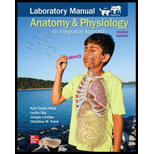
Concept explainers
Introduction:
Blood is a connective tissue which flows from the heart through arteries and veins to all body parts. Whole blood consists of two elements- formed elements and plasma. The total volume of formed elements in the blood which are erythrocyte, platelets, and leukocytes is called as hematocrit. But clinically the total percentage of erythrocytes in blood is known as hematocrit.
Answer to Problem 1DYKB
Correct answer:
The value of hematocrit varies according to sex and age of individuals. The hematocrit of very young children may vary from
Explanation of Solution
Reason for the correct statement:
Option b. is given as “a dehydrated adult male”. The percentage of hematocrit is affected by dehydration condition. If a person has a high hematocrit range it means the person is either suffering from dehydration or is involved in blood doping. As the value of hematocrit is already higher than children and females, its value will increase more in dehydration condition. Thus, the hematocrit value of a dehydrated male will be maximum. Hence; the hematocrit value would be highest in a dehydrated male.
Hence, option b. is correct.
Reasons for the incorrect statements:
Option a. is given as “a 10-year old child”. The hematocrit of very young children may vary from
Option c. is given as “a healthy, nonmenstruating female”. In adult females, the hematocrit value ranges between
Option d. is given as “a healthy, menstruating adult female”. In adult females, the hematocrit value ranges between
Hence, options a., c., and d. are incorrect.
The hematocrit range value would be highest in a ten-year-old boy than a dehydrated male and a healthy female.
Want to see more full solutions like this?
Chapter 18 Solutions
ANATOMY+PHYS.LAB.MANUAL,MAIN VERSION
- ✓ Details Draw a protein that is embedded in a membrane (a transmembrane protein), label the lipid bilayer and the protein. Identify the areas of the lipid bilayer that are hydrophobic and hydrophilic. Draw a membrane with two transporters: a proton pump transporter that uses ATP to generate a proton gradient, and a second transporter that moves glucose by secondary active transport (cartoon-like is ok). It will be important to show protons moving in the correct direction, and that the transporter that is powered by secondary active transport is logically related to the proton pump.arrow_forwarddrawing chemical structure of ATP. please draw in and label whats asked. Thank you.arrow_forwardOutline the negative feedback loop that allows us to maintain a healthy water concentration in our blood. You may use diagram if you wisharrow_forward
- Give examples of fat soluble and non-fat soluble hormonesarrow_forwardJust click view full document and register so you can see the whole document. how do i access this. following from the previous question; https://www.bartleby.com/questions-and-answers/hi-hi-with-this-unit-assessment-psy4406-tp4-report-assessment-material-case-stydu-ms-alecia-moore.-o/5e09906a-5101-4297-a8f7-49449b0bb5a7. on Google this image comes up and i have signed/ payed for the service and unable to access the full document. are you able to copy and past to this response. please see the screenshot from google page. unfortunality its not allowing me attch the image can you please show me the mathmetic calculation/ workout for the reult sectionarrow_forwardIn tabular form, differentiate between reversible and irreversible cell injury.arrow_forward
- 1.)What cross will result in half homozygous dominant offspring and half heterozygous offspring? 2.) What cross will result in all heterozygous offspring?arrow_forward1.Steroids like testosterone and estrogen are nonpolar and large (~18 carbons). Steroids diffuse through membranes without transporters. Compare and contrast the remaining substances and circle the three substances that can diffuse through a membrane the fastest, without a transporter. Put a square around the other substance that can also diffuse through a membrane (1000x slower but also without a transporter). Molecule Steroid H+ CO₂ Glucose (C6H12O6) H₂O Na+ N₂ Size (Small/Big) Big Nonpolar/Polar/ Nonpolar lonizedarrow_forwardwhat are the answer from the bookarrow_forward
 Medical Terminology for Health Professions, Spira...Health & NutritionISBN:9781305634350Author:Ann Ehrlich, Carol L. Schroeder, Laura Ehrlich, Katrina A. SchroederPublisher:Cengage LearningEssentials of Pharmacology for Health ProfessionsNursingISBN:9781305441620Author:WOODROWPublisher:Cengage
Medical Terminology for Health Professions, Spira...Health & NutritionISBN:9781305634350Author:Ann Ehrlich, Carol L. Schroeder, Laura Ehrlich, Katrina A. SchroederPublisher:Cengage LearningEssentials of Pharmacology for Health ProfessionsNursingISBN:9781305441620Author:WOODROWPublisher:Cengage





